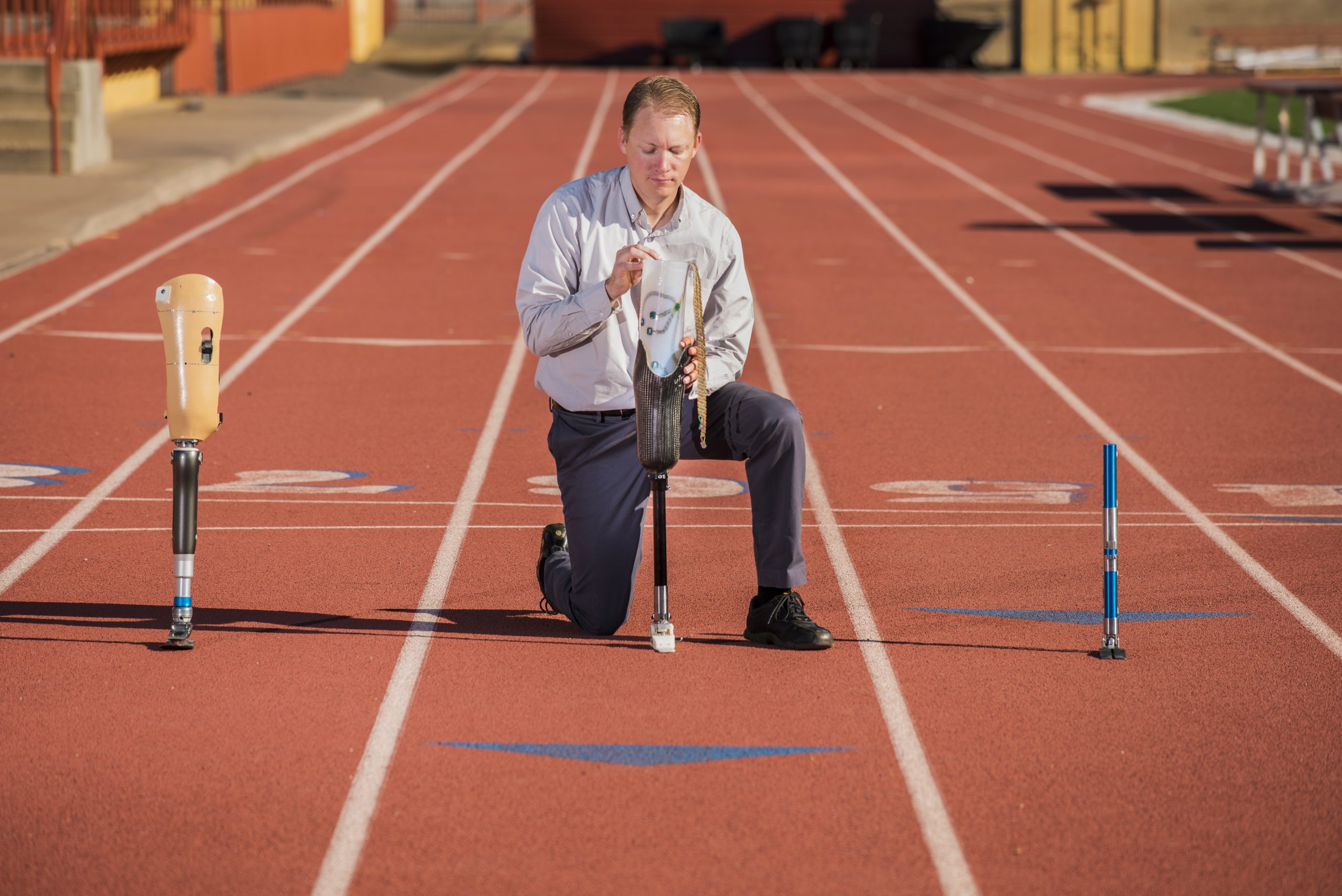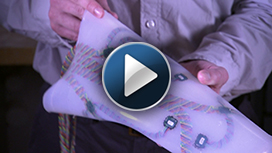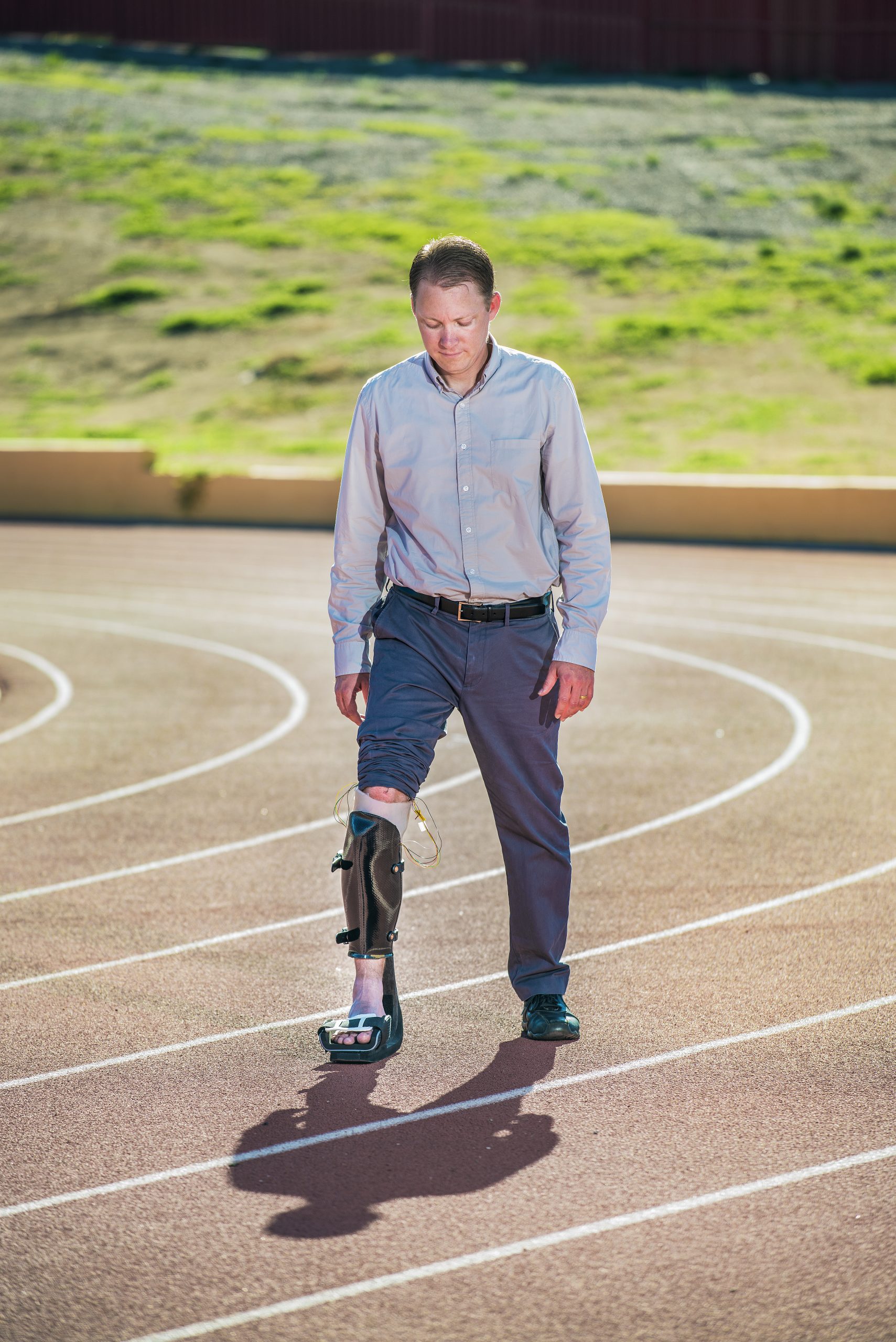ALBUQUERQUE, N.M. — As an amputee walks on a prosthetic leg during the day, the natural fluid in the leg shifts and the muscles shrink slightly.

Now imagine the problem that poses for the fit of the prosthesis.
There’s a growing need for a solution. The national Amputee Coalition says nearly 2 million people in the United States live with limb loss, and about two-thirds have lost a lower limb. That could double by 2050 as diabetes increases. Diabetes is the leading cause of limb loss, accounting for more than 65,000 amputations a year nationwide. In addition, there were more than 1,500 major limb amputations from U.S. battle injuries in Iraq and Afghanistan from 2003 to 2013.
Sandia National Laboratories researcher Jason Wheeler has been studying prosthetics at the labs for a decade and is part of an Intelligent Systems, Robotics and Cybernetics group working to develop a sensor to tell how a limb changes, along with a system that automatically accommodates those changes. After additional testing and refinements, Wheeler hopes to find a company that wants to market the sensor system.
The interface, or socket, between a prosthesis and a limb is custom-made, starting with a cast of the area.
The socket follows that contour, and a clinician adjusts it for the best fit.
In the case of a leg, the prosthesis bears the weight of the wearer when standing or moving. But Wheeler said tissues in your leg, unlike tissues on the bottom of your foot, aren’t well-suited for that pressure. In addition, a limb doesn’t stay the same shape during the day because of fluid fluctuations, and, of course, people gain or lose weight. Thus, a custom-fit socket doesn’t always fit.
Researchers invent sensor that detects pressure in three directions
Robotics researchers developed a small sensor, about the size of a quarter, for inside the socket to monitor fit and detect changes. Sandia researchers have applied to patent the work and have presented papers about it at conferences.
Wheeler said Sandia’s sensor is unique because it detects pressure in three different directions: normal pressure, like when you push your finger down on your thigh, and shear forces in two directions on the skin — think of sliding your finger down and across your leg. Shear forces are important because they cause such problems as rubbing, blisters and abrasions, but no appropriately sized commercial sensing system can monitor them, he said.
So Sandia invented the three-axis pressure sensor, incorporated into a liner that slips into the socket of a prosthesis. Sensors can be distributed to measure three directions at several sites. Other designers have placed pressure sensors in sockets, but those measured only normal pressure, Wheeler said.
“The thing that prevents people from wearing a prosthetic or being satisfied with their prosthesis is comfort,” he said. “Even if you’ve got a high-technology limb, if it’s not comfortable, people won’t wear it.”
Shear pressures in a socket haven’t been well studied, and Sandia wants to understand them better to use that information in developing systems that adjust socket shape to changes in limb shape. “This extra information gives you better ability to know when you need to make modifications because the shear pressures tend to be a little more sensitive to changes in socket shape than normal pressures,” Wheeler said.
System makes adjustments for fit by moving fluid in liners
Sandia’s system automatically adjusts socket shape by moving fluid into bladders inside the liners that amputees normally wear to improve a socket’s fit and comfort. Standard liners are like a stretchy, cushiony sock, just a few millimeters thick, made of a gel-like material that’s a bit sticky to help hold everything in place.

Since modifying a custom socket would be expensive and cumbersome and could require several fittings, Sandia adapted its technology to fit inside a liner made of elastomeric material similar in thickness to a gel liner.
“With the liner, you just take out your old one and drop in the new one and you’re good to go. That’s a very important component of this technology,” Wheeler said.
The Sandia system adjusts to limb changes by placing bladders inside the liners, and filling the bladders using valves and pressurized liquid on the outside of the liner. Prototypes have been developed to fill and empty the bladders automatically, but Wheeler said more research is needed to determine when it’s best to add and remove fluid.
A liner can incorporate both sensors and bladders inside, depending on the need. “Sometimes you might just want to sense, sometimes you might just want to fill a bladder, sometimes you might want to do both, so the system is flexible enough you can create a liner that does any of those functions,” Wheeler said.
Amputees currently add special fitted socks on their limb to deal with fluid loss and shrinkage. It’s an imperfect solution, forcing them to keep socks on hand and to take off the prosthesis to change them.
It’s also imperfect because the leg loses volume in muscles but not where it’s largely bone, such as the front of the tibia. A sock adds volume everywhere, distributing pressure unevenly. In contrast, a bladder system adds volume only where needed. “Being able to put additional fluid volume locally, where you lost it, is an important component,” Wheeler said.
Sensors, adjustment system have undergone limited testing; more work planned

Sandia, through a partnership with the University of Washington, has done limited testing with a prototype sensor liner. Wheeler also tested it, using a liner cut out at the bottom so he can slip it on his leg. Then he uses a clamp-on two-piece socket with an artificial foot so he walks on the artificial foot underneath his own foot, which shifts the load to his leg. Amputees also have tested prototype liners with the integrated bladders.
The sensor and bladder systems have not yet been tested together as a closed loop system.
“Right now, we don’t really understand the right method to control the fluid movement,” Wheeler said. “When you walk you have all these different signals and they’re telling you something, but due to limited research in this area it’s not entirely obvious what the signals mean. We need to do more studies to learn what those signal changes mean about how to adjust socket shape.”
Other institutions have worked on closed loop systems, but Wheeler said Sandia’s development of liners with both sensors and automatic fluid adjustment is unique. “That capability to construct liners with things built right into them should be of a lot of interest to the orthotics and prosthetics community,” he said.
Sandia’s robotics group began prosthetics research more than a decade ago through the Department of Energy’s proliferation prevention programs, initially collaborating on humanitarian projects with Russian companies. Wheeler, who has a background in mechanical engineering and assistive robotics, worked on some of those programs when he joined Sandia in 2004. The robotics group has continued prosthetics research with funding from the Department of Defense Peer Reviewed Orthopaedic Research Program, which develops technology for veterans. “We have the expertise here and it relates to our national security missions,” said Wheeler. He said prosthetics research and development is an ideal way to combine his expertise in mechanical design and biomedical engineering with his desire to help injured people.
Development is continuing and more amputee testing is needed, but the technology “is getting mature enough where before too long, if we want it to be successful, we’re going to have to hand it off to a commercial entity to market it,” Wheeler said.